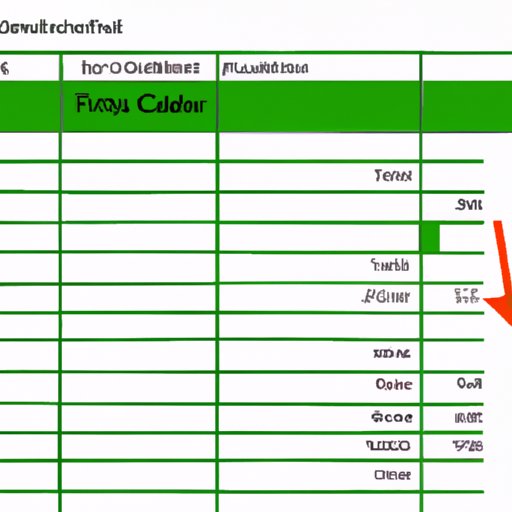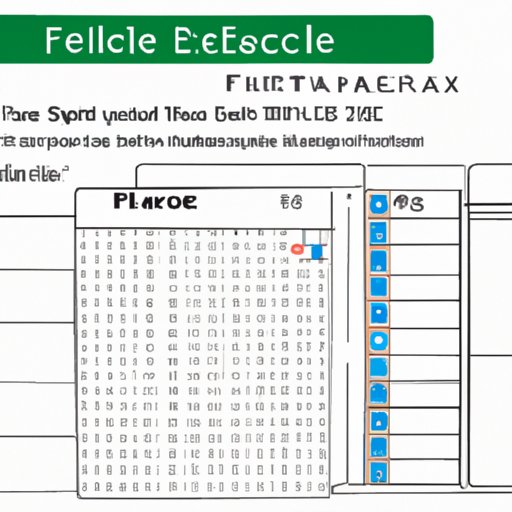Introduction
Data cleaning is an essential step in the data analysis process. It involves inspecting, transforming, and reorganizing raw data into a more useful format for further analysis. The goal of data cleaning is to improve the accuracy and quality of the data by removing invalid or incorrect values, filling in missing values, and ensuring consistency in the data set.
Cleaning data manually can be a time-consuming and tedious process, but fortunately, there are a variety of ways to automate the process in Microsoft Excel. In this article, we’ll explore some of the techniques and tools that can be used to streamline data cleaning in Excel and make the process faster and easier.
Utilizing Excel’s Built-in Functions to Automate Data Cleaning
Excel has a number of powerful built-in features that can be used to automate data cleaning. Let’s take a look at some of the most useful ones.
Sorting Data
One of the quickest and easiest ways to clean up data in Excel is to sort it. By sorting the data, you can quickly identify and remove duplicate values, as well as outlier values that don’t belong. You can also use sorting to arrange the data in a more logical order, making it easier to analyze.
Filtering Data
Another useful tool for data cleaning is Excel’s filtering feature. With filtering, you can easily hide or show specific rows or columns based on criteria you specify. This makes it easy to narrow down the data set to only the values you want to work with, eliminating any unnecessary clutter.
Using Formulas for Calculations
Excel’s formulas can also be used to automate data cleaning. For example, you can use formulas to calculate averages, totals, and other summary statistics for numeric fields. You can also use formulas to find and replace text in cells, which is helpful for identifying and correcting typos and other errors.

Using Conditional Formatting in Excel to Highlight Unwanted Data
Conditional formatting is another powerful feature of Excel that can be used to automate data cleaning. With conditional formatting, you can create rules based on cell values that cause cells to be highlighted or shaded when certain conditions are met. This is especially useful for identifying outliers and discrepancies in the data set.
Setting Up Rules Based on Cell Values
The first step in using conditional formatting for data cleaning is to set up rules based on cell values. For example, you can set up a rule that highlights any cells containing a value that is greater than the average for the column. This makes it easy to spot potential errors in the data.
Applying Color Coding
Once you’ve set up your rules, you can apply color coding to make it easier to identify unwanted data. For example, you can use red to highlight values that are outside the normal range, yellow to indicate values that are close to the average, and green to indicate values that are within the acceptable range.

Employing the Find and Replace Functionality of Excel
Excel’s Find and Replace feature can also be used to automate data cleaning. With Find and Replace, you can quickly locate and replace specific values in the data set with either a value or formula you specify. This can be useful for fixing typos, replacing incorrect values, and updating outdated information.
Replacing Values with Formulas
Using Find and Replace, you can replace existing values with formulas. This is particularly useful for calculating summary statistics, such as averages, totals, and counts. For example, if you have a column of numbers, you can use a formula to calculate the average and then use Find and Replace to replace all the values in the column with the calculated average.
Locating and Replacing Text
Find and Replace can also be used to locate and replace text in cells. This can be useful for correcting typos and other errors in the data set. For example, if you want to replace all occurrences of the word “incorrect” with the word “correct,” you can use Find and Replace to quickly do so.
Leveraging VBA Scripts to Automate Data Cleaning
VBA (Visual Basic for Applications) is a powerful scripting language that can be used to automate tasks in Excel. Using VBA, you can write macros to automate repetitive tasks and create custom functions that can be used to perform calculations on the data set.
Writing Macros to Automate Repetitive Tasks
Macros are small programs that you can write in VBA to automate repetitive tasks. For example, if you have a data set that needs to be cleaned on a regular basis, you can write a macro to do the job for you. This can save you a lot of time and effort in the long run.
Creating Custom Functions
VBA can also be used to create custom functions that can be used to perform calculations on the data set. For example, you can create a function that calculates the median value of a column or a function that counts the number of unique values in a column. These functions can be used in conjunction with other Excel features to automate data cleaning.

Applying Filters to Sort and Remove Unwanted Data
Excel’s filtering feature can also be used to sort and remove unwanted data. By applying filters, you can quickly narrow down the data set to just the values you want to work with. You can also use advanced filtering options to find and remove duplicates or outliers from the data set.
Selecting the Appropriate Criteria
When applying filters, it’s important to select the appropriate criteria. For example, if you want to remove duplicate values from the data set, you should select the option to filter by “unique values only.” Similarly, if you want to find and remove outliers, you should select the option to filter by “values outside the average range.”
Utilizing Advanced Filtering Options
Excel also offers advanced filtering options that can be used to further refine the data set. For example, you can use the “top 10” filter to find and remove the top or bottom 10 values in a column. You can also use the “by color” filter to quickly identify and remove any cells that have been highlighted with a particular color.
Exploring Third-Party Add-Ons to Streamline Data Cleaning
In addition to Excel’s built-in features, there are also a number of third-party add-ons that can be used to streamline data cleaning. These add-ons can help automate tedious tasks, such as finding and replacing text, and they can also provide additional features, such as pattern matching and fuzzy logic.
Examining Popular Add-Ons
There are a number of popular add-ons available for data cleaning in Excel. Some of the most popular ones include Power Query, EasyMorph, and Trifacta Wrangler. Each of these add-ons offer different features and capabilities, so it’s important to evaluate them carefully to determine which one is best suited for your needs.
Evaluating Pricing and Features
When evaluating third-party add-ons, it’s important to consider both the price and the features offered. Some add-ons may offer more features than others, but they may also be more expensive. It’s important to weigh the cost against the benefits to ensure you’re getting the best value for your money.
Conclusion
Data cleaning is an essential step in the data analysis process, but it can be time-consuming and tedious. Fortunately, there are a number of tools and techniques that can be used to automate the process in Excel. By utilizing Excel’s built-in features, leveraging VBA scripts, applying filters, and exploring third-party add-ons, you can streamline the data cleaning process and make it faster and easier.
Summary of Steps
To summarize, here are the steps for automating data cleaning in Excel:
- Sort the data to identify and remove duplicates and outliers
- Use filtering to narrow down the data set
- Utilize formulas to calculate summary statistics
- Apply conditional formatting to highlight unwanted data
- Employ the Find and Replace functionality to locate and replace text
- Leverage VBA scripts to automate repetitive tasks
- Explore third-party add-ons to streamline data cleaning
Further Resources
For more information on automating data cleaning in Excel, check out the following resources:
- How to Automate Data Cleaning in Excel
- Use Conditional Formatting in Excel
- Writing Macros with VBA in Excel
-
(Note: Is this article not meeting your expectations? Do you have knowledge or insights to share? Unlock new opportunities and expand your reach by joining our authors team. Click Registration to join us and share your expertise with our readers.)
